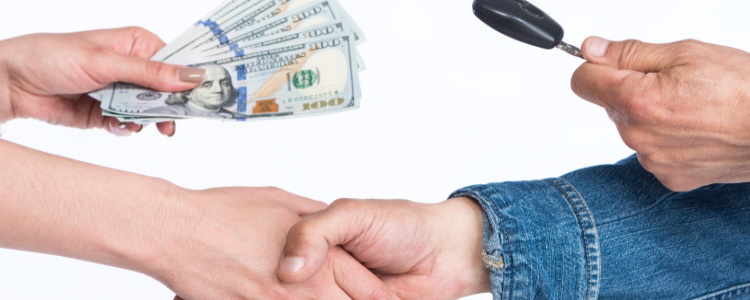When you’ve never traded in a vehicle before, it can feel daunting since dealers are often experienced in the art of negotiating. To help you prepare for a trade-in, we’re covering the basics so you can walk into a dealership with confidence.
The Trade-In Process
Many borrowers trade in their old ride to help with the cost of their next one. In fact, according to the Nation Automobile Dealers Association (NADA) around 22% of used car sales historically involve a trade-in, and around 40% of new-car buyers use a trade-in.
When you're new to the trade-in process, it's important that you know the terminology you're likely to hear, and how the process works. Let's take a look:
- Actual cash value (ACV) – The actual value of your car is determined by a dealer. This is unique to your vehicle.
- Trade-in value – The estimated value and offer you may receive from a dealer by trading in your car.
- Private party value – The estimated offer you may receive from a private party, typically higher than the trade-in value. Serves as a guide to selling your vehicle privately.
- Equity – When you have a loan on the car, but the vehicle value is more than the loan balance. If you don’t have an auto loan, then its entire value is equity.
- Negative equity – When your loan balance is more than the vehicle’s ACV, also called being underwater or upside-down.
- 10-day payoff amount – The amount you must pay to complete your auto loan. Your lender can provide you with this information. If you’re trading in a car with a loan, knowing your loan balance helps you know how much you need to transfer ownership to the dealership.
Now that you’re armed with the jargon you’re likely to hear from a dealer during the trade-in process, here’s how it typically works:
- Find a dealership you’d like to work with.
- Tell a dealer you have a trade-in and you’d like an offer.
- The dealer asks you about the car’s history and condition.
- Dealer evaluates and researches the car’s ACV.
- The dealer gives you an offer for the vehicle, if able.
- You can either accept, decline, or negotiate the offer.
- If you accept, the dealer pays off your current lender if you have a loan, hands you a check for the value if you're not making another purchase, or can apply leftover money to your next down payment.
- Complete any transaction paperwork required by your state and sign the title over to the dealership.
Trade-Ins Are Useful
A trade-in is useful for many reasons, but the biggest advantage of having one is using the value of the vehicle to knock down the price of your next vehicle purchase.
If you’re looking to knock down the selling price of your next vehicle, a trade-in could help you do just that. When you still have a loan on your car, your first priority is paying off your current lender, since you don't officially own the car, you can't sign over the title until you remove the lienholder. Then, if there's any money left over, you can use the remaining amount — the vehicle's equity — to lower the amount you pay for your next purchase.
For example: Say you owe $2,000 on your current loan and the vehicle is estimated to sell for around $10,000 on average. That’s around $8,000 in equity that can be used to lower your next car’s selling price — if you can get that much for it from a dealer. Dealer trade-in offers' tend to be a little lower than the price you might get selling the car yourself since they typically need to make a profit on the sale for it to be worthwhile.
You can research your trade-in’s estimated value on websites such as Kelley Blue Book and/or NADAguides to get an idea of what your vehicle’s worth.
Bad Credit Borrower Benefit
Trade-ins that have equity are very helpful to bad credit borrowers, as well. Where there’s bad credit, there’s almost always a down payment requirement for vehicle financing eligibility.
Saving a large enough down payment to cover a lender requirement can prove challenging for many borrowers, but your trade-in’s equity can help you meet (or completely satisfy) that requirement!
Negotiating Your Trade-In Offer
 Arguably, the most difficult part of a trade-in is getting the gumption to negotiate the offer from a dealer. But fear not – one of the easiest ways to gain leverage is by simply getting offers from other dealers.
Arguably, the most difficult part of a trade-in is getting the gumption to negotiate the offer from a dealer. But fear not – one of the easiest ways to gain leverage is by simply getting offers from other dealers.
Most of the time, a trade-in offer is good for around ten days. This can give you some time to get other prices from surrounding dealers. And in many cases, you don’t even need to physically visit a dealership to get an estimated trade-in offer (although an in-person offer is going to be more accurate). We recommend calling at least three different dealerships in your area – make sure at least one of those dealerships is franchised with your vehicle’s manufacturer. For example, if you have a Ford, call a Ford dealership, because they may offer you more for your trade-in.
Once you’ve got a few offers on the table, you can whittle them down to the dealers that you want to work with. If you have your eye on a specific dealership because they have the car you want, tell them about other, higher offers you've received. They may be willing to meet you in the middle or match the offer to persuade you to shop with them.
Another tip with negotiation has to do with the timing of when you mention you have a trade-in. It’s often recommended that borrowers who plan on buying a vehicle and using a trade-in as a down payment should negotiate the selling price of their next car first.
Once you and the dealer agree to a price, then mention the trade-in. Some unscrupulous dealerships may not be willing to negotiate the selling price of your next car as much if they know you’re already knocking down the price with trade-in equity.
Finding a Dealership With Poor Credit
For borrowers with less than perfect credit, finding a dealership that’s signed up with bad credit auto lenders can be stressful. If you’re planning on buying another vehicle once you’ve traded yours in, and you need financing, you may need the assistance of subprime lenders if your credit score isn’t totally stellar.
Finding a dealer that’s able to work with tough credit circumstances can be as easy as completing our free auto loan request form. At Auto Credit Express, we’ll do the hard work of finding a dealership in your local area that’s signed up with bad credit lending resources. There’s no cost and no obligation to let us find a dealer for you – so get started now!
















